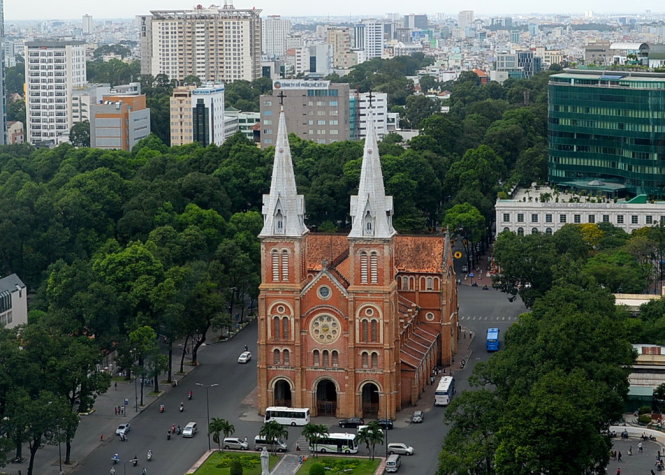A large-scale restoration, which may take several years, is expected to start on the 135-year-old Saigon Notre-Dame Basilica in three months.
The revamp may take several years to complete, Ho Van Xuan, Head of the Archdiocesan Office of the Archdiocese of Ho Chi Minh, told Tuoi Tre (Youth) newspaper on Saturday.
Xuan, chief of the cathedral’s restoration board, is poised to visit France and meet producers of colored glass and tiles that may go well with the church's architecture.
He said a plan was devised to restore the Saigon Notre-Dame Basilica over 10 years ago.
However, the cathedral’s makeover ranked behind projects to be carried out on other structures in the city regarding priority.
“Despite its normal look from the outside, the church has seen substantial damage,” Xuan stressed. "So restoration can no longer be procrastinated."
The damage is most serious in the edifice’s tile roofs due to accumulative rainwater, which leads to further structural impairments and imperils its overall force sustaining system.
“We’re enormously concerned that with further delays, the damaged items would pose a danger to parishioners who come to the church for weekly services. We would also be held accountable to our predecessors if the damage turns extensive and irreparable,” he explained.
Earlier, the Archdiocese of Ho Chi Minh City had sought permission from the municipal People’s Committee and the Department of Culture and Sports regarding the overhaul.
Built in 1877 and opened to the public in 1880, the 135-year-old church has not seen any major restoration.
The edifice adopted French architecture traits, with all the construction materials imported from France.
The chancel adopts Roman and Gothic architecture, which are conducive to the edifice’s elaborateness, elegance, and tastefulness.

The Saigon Notre-Dame Basillica is pictured during a moonlit night. Photo: Tuoi Tre
Xuan noted that there are concerns the upcoming restoration may mar the church’s original charm.
Tiling alone is a daunting task, he added.
An estimated 50,000 pieces of tile, including original Marseille tiles from France and local ones, have replaced damaged originals in separate small-scale repairs.
Now that the culture department favors the use of original Marseille tiles, Xuan and other members of the restoration board have contacted their counterparts in France.
“Used tiles are out of the question, as we have no way to inspect their quality. Meanwhile, ordering and importing new ones are costly and troublesome. We have contacted a local hi-tech producer, who also finds the original French tiles’ color and ancient look quite difficult to imitate,” Xuan said.
The priest added he and others will go to great lengths to make sure the church’s original beauty is retained.
He also pointed out that maximal safety must be ensured for workers, passers-by and congregation members who come to the church for weekly religious services.
The church will remain open in the early phase of the facelift.
Xuan added they plan to order a specially-built scaffold and seek the city’s permission to use part of the street to put it up, as the sidewalk is quite narrow.
The overhaul will start with the roof tiles before the bell tower and interior are given a makeover.
The bell tower, which is over 60 meters tall, also poses a safety challenge, Xuan said.
The restoration will aim to make the church more airy.
The revamp of the Saigon Notre-Dame Basilica is one of the key projects to be carried out by the Archdiocese of Ho Chi Minh City in the several years to come, according to Xuan.
However, the priest and other members will raise funds for the project from the clergy and parishioners.
Xuan also voiced his resentment that a number of mindless visitors have doodled all over the church’s walls.
“We’re considering erecting a nice fence to stop visitors from touching the walls. However, the fence may spoil the church’s look and isolate the edifice from its environs,” he said.
The Archdiocese of Ho Chi Minh City also plans to work with the District 1 People’s Committee on erecting a statue of Mother Maria and growing plants, as well as putting an end to peddling in the area.
Le Ton Thanh, vice director of the municipal Department of Culture and Sports, told Tuoi Tre that the Archdiocese of Ho Chi Minh City has yet to submit documents regarding the restoration.
“The city is really supportive of the project to revamp the Saigon Notre-Dame Basilica and will work to ensure the restoration complies with certain regulations,” Thanh noted.
Like us on Facebook or follow us on Twitter to get the latest news about Vietnam!


















































